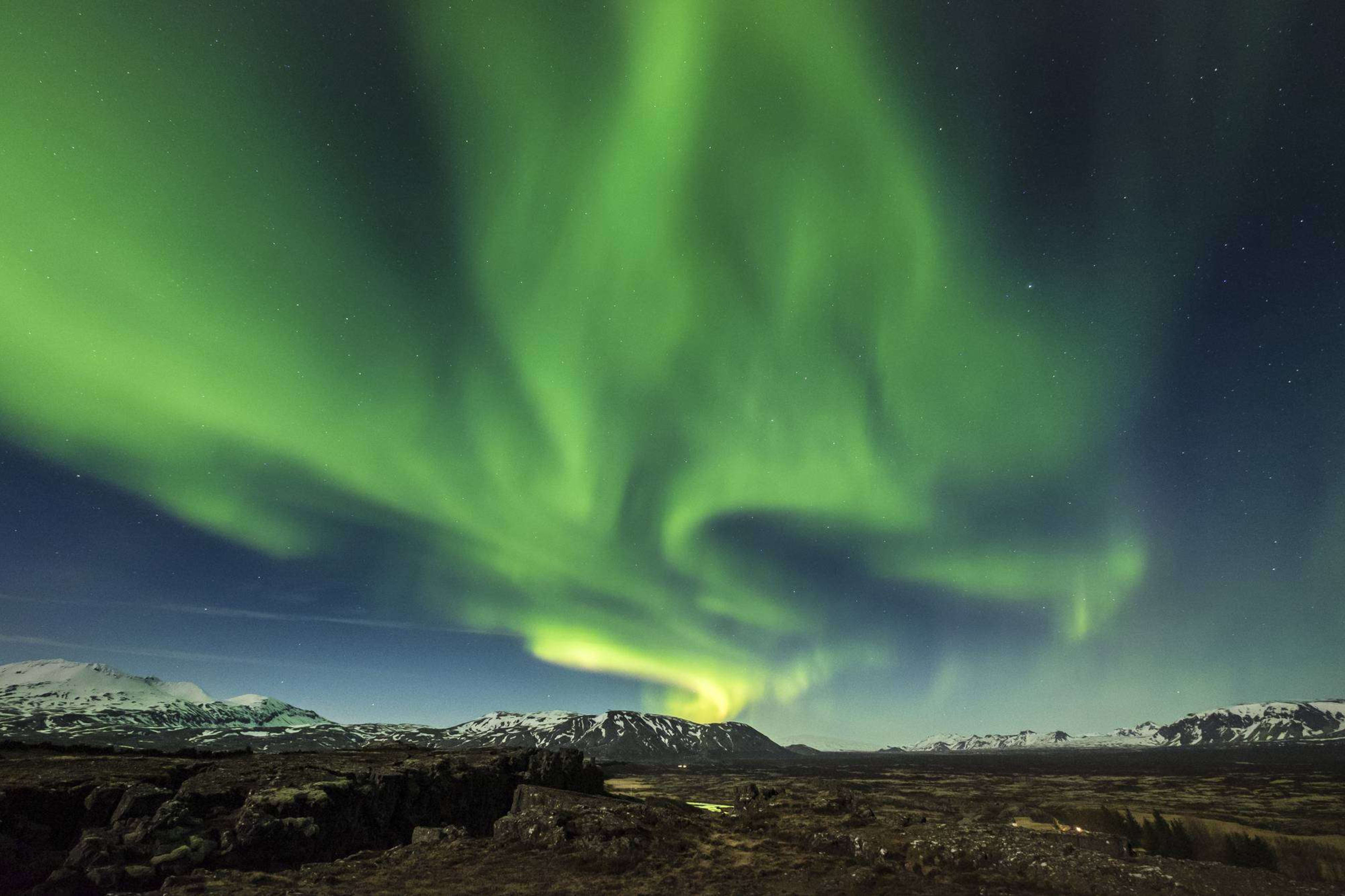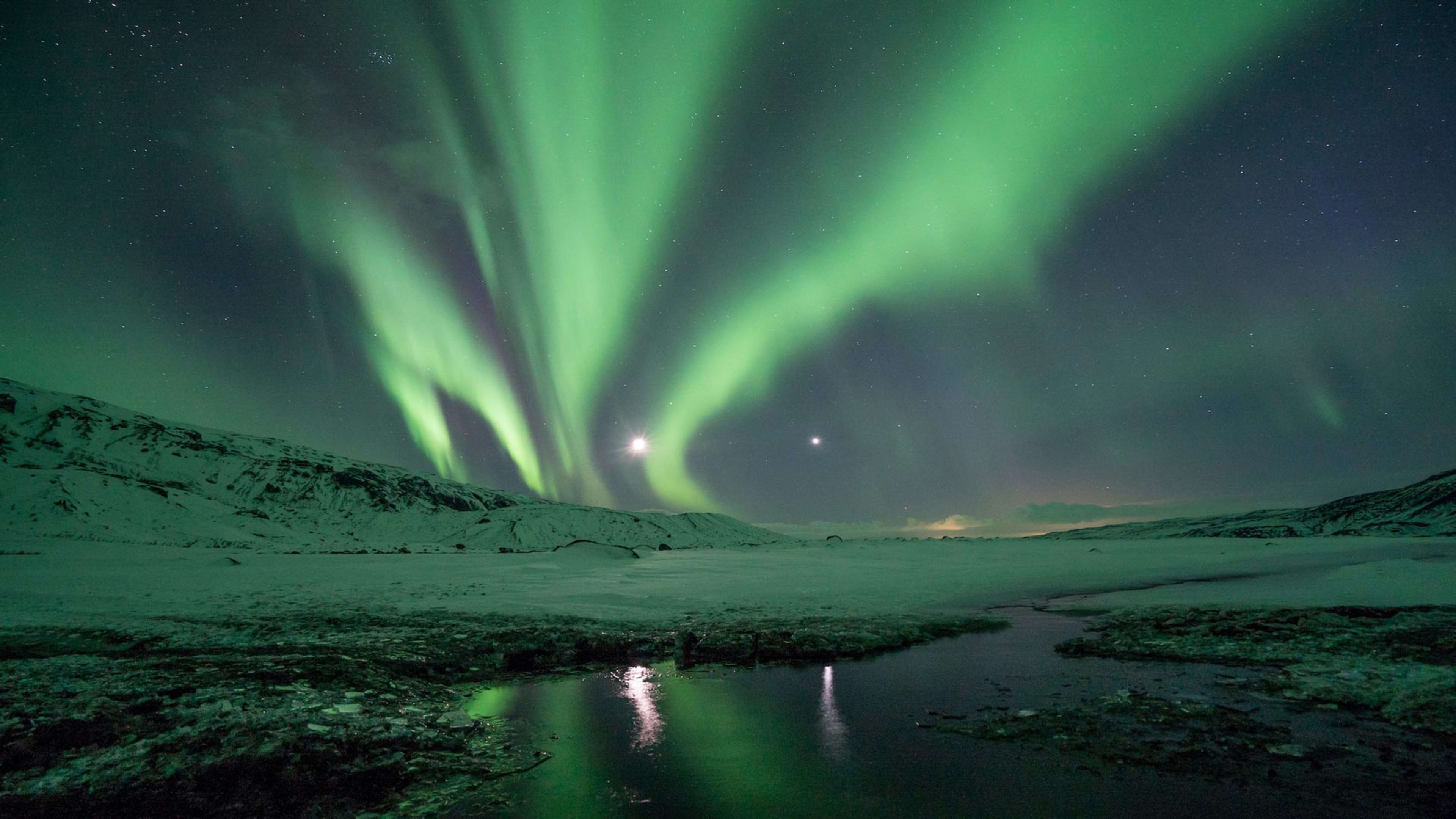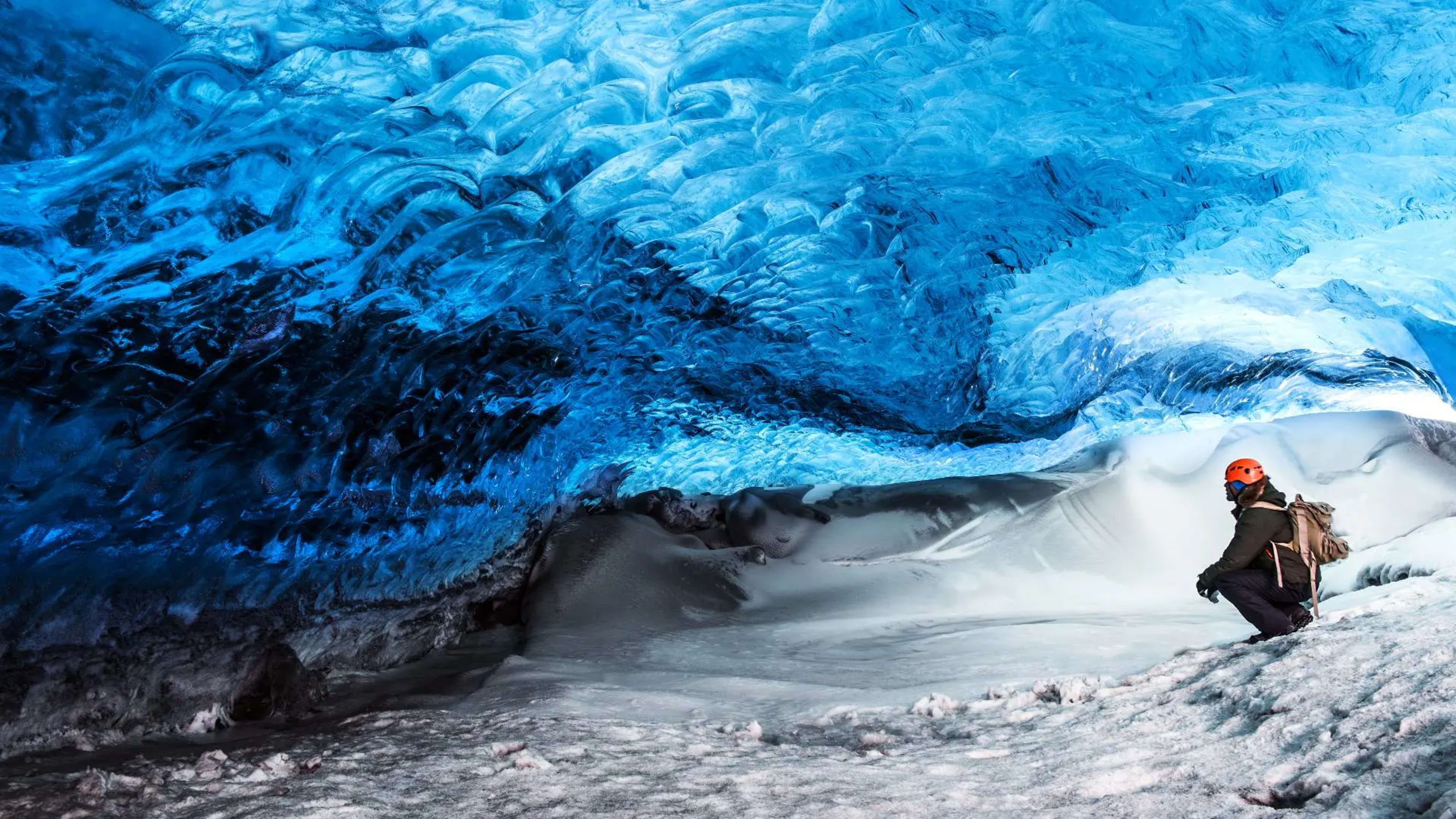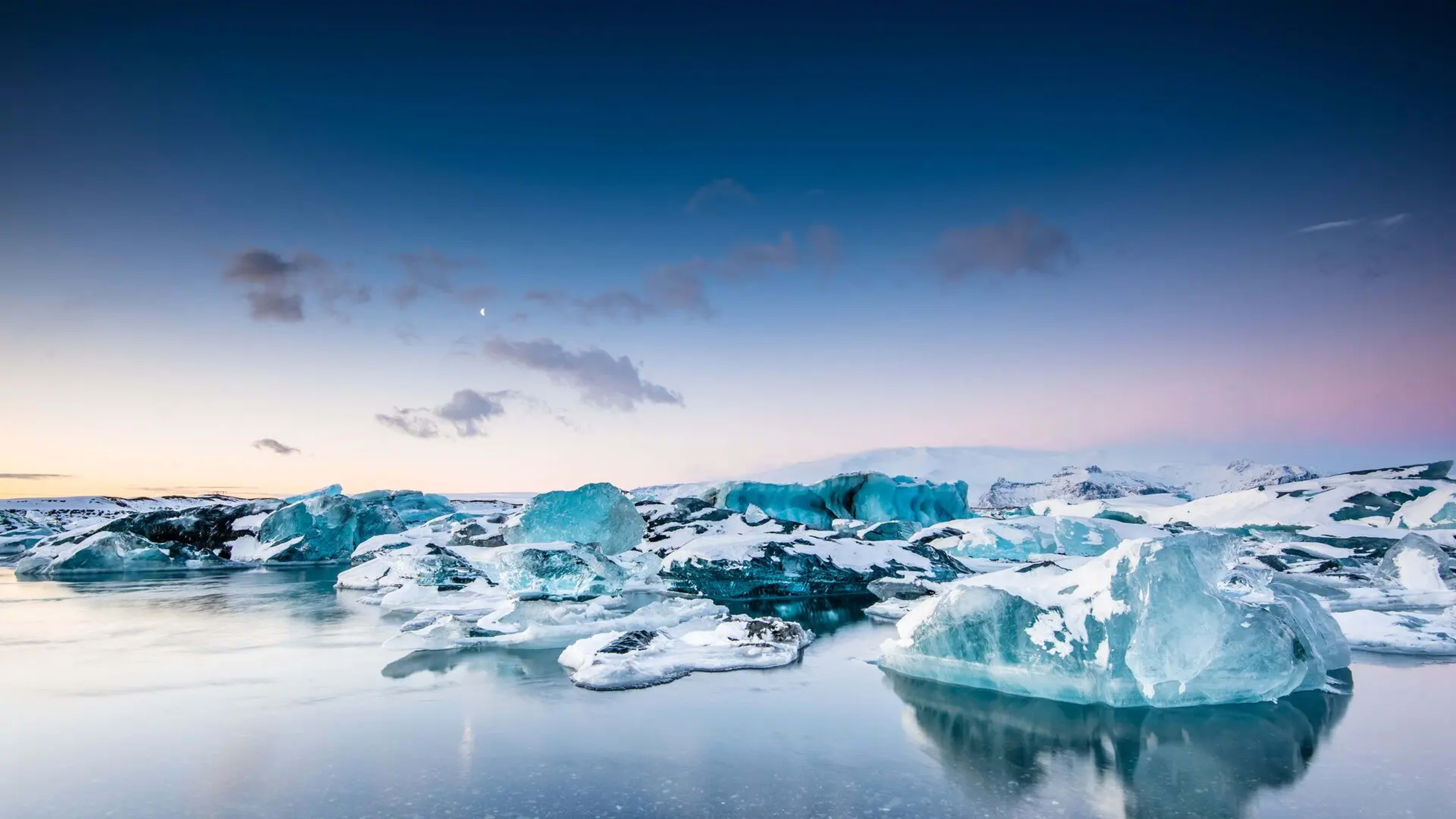Few experiences compare to standing under the winter Northern Lights in Iceland, where waves of green and purple light sweep across the Arctic sky. With glaciers, black sand beaches, and snow-covered mountains as the backdrop, the aurora transforms the landscape into something magical.
Because the lights are elusive, knowing when to go, where to look, and how to prepare makes all the difference. This guide will show you the best times, places, and tips to help you plan your ultimate Northern Lights adventure.
What other ways can you experience it best, other than joining Northern Lights tours in Iceland?
Why Winter is the Best Time for Northern Lights in Iceland
Winter is the prime season for Northern Lights viewing in Iceland, and for good reason. The most obvious advantage is the long, dark nights. From late September through early April, Iceland experiences extended hours of darkness, especially in December and January, when daylight can be as short as four to five hours.
These long nights create the perfect canvas for the aurora borealis to appear. Unlike summer, when the midnight sun keeps the skies too bright, winter offers the darkness required to see the lights clearly.

What Causes the Aurora Borealis?
For centuries, people have explained the Northern Lights with myths and legends. In Old Norse tradition, they were thought to be the glimmer of Valkyrie shields guiding warriors to Valhalla. In Finnish Lapland, a mythical fox was said to sweep sparks into the sky with its tail, giving the lights their Finnish name, revontulet or “fox fires.” Others saw them as omens or messages from the spirit world.
Today, science offers a more precise explanation, though no less fascinating.
The aurora occurs when charged particles from the Sun, carried by solar wind, collide with Earth’s magnetic field. While most particles are deflected, some are drawn toward the polar regions, where they interact with gases in the upper atmosphere.These collisions excite oxygen and nitrogen molecules, causing them to release energy in the form of light. The colors depend on altitude and gas type: green from oxygen at lower altitudes, red from oxygen at higher altitudes, and purple or blue from nitrogen.
Because auroras concentrate around the polar regions, Iceland’s position near the Arctic Circle, directly under the Auroral Oval, makes it one of the world’s most reliable places to see them.
Trivia: In the Southern Hemisphere, the same phenomenon is called the aurora australis, or “southern lights.”
Best Time of Year to See the Northern Lights in Iceland
The winter Northern Lights are most visible in Iceland from late September to early April, when nights are long and skies are dark. The peak season is October through March, with December and January offering the longest nights.
Best times to see the aurora:
- Months: October to March, with December and January experiencing up to 20 hours of darkness.
- Hours: 9:00 PM to 2:00 AM, though displays can appear earlier or later.
Read more in detail on the best times to see the aurora in Iceland.
Conditions for better viewing:
- Strong solar activity creates brighter and more colorful auroras
- Clear skies are essential, since clouds block the view entirely
- Dark surroundings away from city lights improve visibility
Pro tip: Plan around the moon. A new moon provides the darkest skies, while a full moon can wash out fainter auroras.
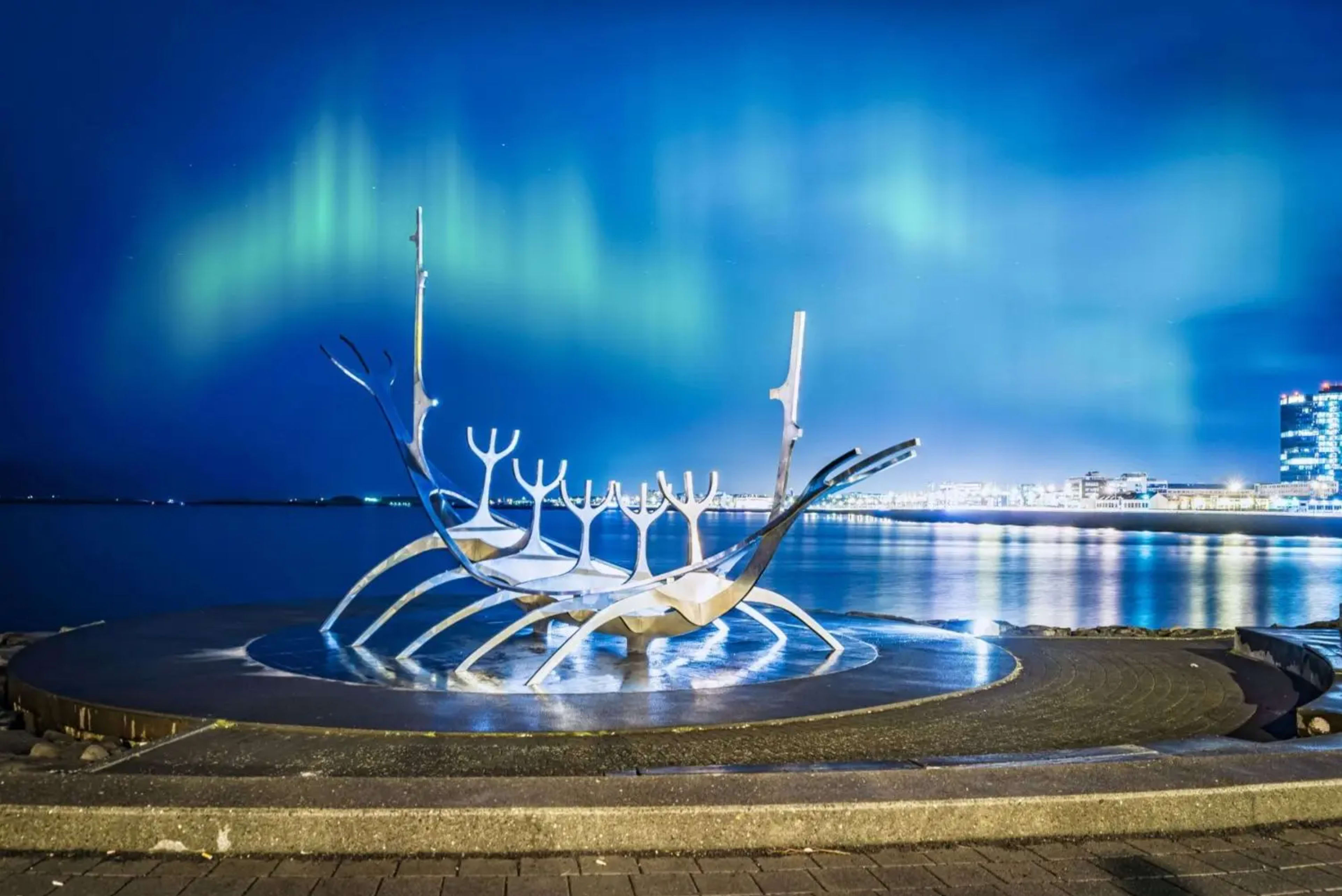
Top 5 Viewing Spots to See the Winter Northern Lights in Iceland
Iceland has no shortage of beautiful spots to watch the aurora, but these five places stand out for their wide horizons, low light pollution, and unforgettable scenery.
1. South Coast
The South Coast is one of the most rewarding regions for aurora hunting, with easy access from Reykjavík and a mix of iconic sights. Top spots include Jökulsárlón Glacier Lagoon and Diamond Beach, where the lights reflect off icebergs and black sand, and Vík, known for its sea stacks and wide horizons. Even if the lights don’t appear, don’t worry; you’ll never run out of things to see and do on the South Coast.
If you want to cover several sights in a single day or more, check out our South Coast tours.
2. North Iceland
Known for its clear skies and fewer crowds, North Iceland offers excellent aurora views. Highlights include Lake Mývatn, where volcanic landscapes and reflective waters create surreal views, and Siglufjörður, a charming fishing village between mountains and sea. The region feels wilder and more remote, but guided North Iceland tours make it accessible and safe during winter.
3. Snæfellsnes Peninsula
Called “Iceland in Miniature,” Snæfellsnes Peninsula combines mountains, lava fields, fishing villages, and coastline all within a few hours of Reykjavík. Kirkjufell Mountain is the star, one of Iceland’s most photographed aurora backdrops. Other great viewing points include the Snæfellsjökull Glacier and the cliffs at Arnarstapi, where the skies are dark and horizons wide.
4. Westfjords
Remote and rugged, the Westfjords offer some of the darkest skies in Iceland. Ísafjörður makes a good base, while the nearby beaches and fjords provide unobstructed views. Winter access can be challenging, but those who make it are rewarded with brilliant displays far from any light pollution.
5. Þingvellir National Park
Just an hour from downtown Reykjavík, Þingvellir National Park offers dark skies and open landscapes ideal for aurora viewing. Its reflective lake, Þingvallavatn, often doubles the spectacle on calm nights. Since it’s part of the Golden Circle, it’s easy to combine daytime sightseeing with nighttime aurora hunting.
Bonus: Reykjavík
Though city lights reduce visibility, auroras sometimes appear right over the capital. Good spots include Öskjuhlíð Hill, Klambratún Park, Elliðaárdalur Valley, and the harbor area. For better chances without going far, head to Grótta Lighthouse, where the dark ocean horizon makes it Reykjavík’s most reliable viewing point.
Want to know more about Iceland’s capital? Read our guide on the best things to do in Reykjavík.
Winter Activities to Pair with Northern Lights Hunting
Chasing the aurora is often the highlight of a winter trip to Iceland, but it’s far from the only experience the season has to offer. During the short daylight hours, there’s plenty to see and do before heading out again at night to look for the winter Northern Lights.
- Soak in geothermal lagoons – Relax in warm waters at the Blue Lagoon, Sky Lagoon, or Mývatn Nature Baths while the snow falls around you.
- Ice caving – Explore glittering blue ice tunnels inside Vatnajökull Glacier, a natural wonder that forms fresh each winter.
- Lava caving – Step into ancient volcanic tubes where cold air creates shimmering ice sculptures among the rock.
- Glacier hiking – Strap on crampons and walk across vast icefields for sweeping views of Iceland’s frozen landscapes.
- Snowmobiling – For more adrenaline, race across glacier plateaus on a guided snowmobile tour.
- Chasing waterfalls – Skógafoss, Seljalandsfoss, and Goðafoss become even more dramatic when framed by snow and ice.
- Horseback riding – Ride Icelandic horses through snowy landscapes for a quiet, traditional way to experience the countryside.
- Whale watching – From Reykjavík or Húsavík, spot orcas, humpbacks, and other marine life in the winter seas.
Chase the Winter Northern Lights: Guided Tour or Self-Drive?
One of the big decisions when planning your aurora adventure in Iceland is whether to set off on a self-drive or join a guided tour. Both have their appeal, and the right choice depends on your comfort level and how you want to experience the country.
Self-Driving
Self-driving gives you the freedom to set your own pace, follow the forecasts, and stop wherever the skies are clear. For confident winter drivers, it’s a rewarding way to explore. But winter roads can be icy and unpredictable, so a 4×4 vehicle, careful planning, and constant weather checks are essential.
Tip: For a more curated experience, book self-drive tours. Also, check out our guide on getting around Iceland.
Guided Tours
Guided tours take the stress of driving away, allowing you to focus on the experience. Local guides know the best dark-sky locations and how to adapt if the weather shifts. Many tours also include a free reschedule if you don’t see the lights on your first attempt.
Popular types of winter Northern Lights tours include:
- Bus tours – Small groups with flexible routes
- Super jeep tours – Off-road access to remote areas
- Boat tours – Watch the aurora from the sea, away from coastal lights
- Multi-day tours – Combine sightseeing with nightly aurora hunts
- Combo tours – Pair aurora watching with glacier hikes, snowmobiling, or cave tours
For a more complete experience, the 8-Day Northern Lights Ring Road Small Group Tour circles the entire island, covering the Golden Circle, South Coast, Eastfjords, and North Iceland. With countryside stays each night, you’ll maximize your aurora chances while also seeing Iceland’s waterfalls, glaciers, and volcanic landscapes.
Essential Tips to Improve Your Chances of Seeing the Aurora
Seeing the Northern Lights is never guaranteed, but preparation can significantly improve your chances. Here’s how to maximize your chances and make the experience more comfortable and rewarding.
What to Wear
- Layered clothing – Thermal base, insulating middle (fleece or down), and waterproof, windproof shell
- Insulated boots – Waterproof with good traction, paired with wool socks
- Accessories – Warm gloves, hat, scarf or buff, as well as hand and foot warmers
For more, check out our guide to packing for Iceland in winter.
What to Bring
- Snacks – Keep energy levels up during extended nights outdoors
- Thermos – A hot drink can make long, cold waits much more enjoyable
- Seat pad or foldable stool – Helps make the long waits comfortable
How to Capture the Lights
Capturing the aurora is all about stability, the right gear, and the right settings.
Things to bring:
- Tripod – Essential for steady long exposures
- Camera gear – DSLR or mirrorless with good low-light capability
- Lens – Wide or ultra-wide angle to capture as much sky as possible
- Shutter release or timer – Prevents blurring when pressing the shutter
- Extra batteries – Cold drains power quickly, so keep spares warm in your pockets
- Red-light headlamp – Preserves night vision and can help illuminate people in photos without ruining the aurora (use sparingly, as not to distract others)
Recommended camera settings:
- ISO – 800-1600
- Aperture – f/2.8 or lower
- Exposure – 5-15 seconds
- Focus – Switch to manual and set to infinity, or focus on a distant light
- Format – Shoot in RAW for maximum editing flexibility
How to Maximize Your Chances
- Find darker skies – Move away from artificial light for the clearest displays
- Check forecasts – Use the Icelandic Meteorological Office for aurora and cloud cover
- Download aurora apps – Tools like Hello Aurora or My Aurora Forecast give push notifications when activity spikes.
- Use webcams – Several across Iceland stream live aurora conditions
- Join guided group tours – Guides know the best spots and often offer free reschedules
- Stay at aurora hotels – Many will alert guests if the lights appear during the night
- Stay flexible – Weather shifts quickly; have backup plans or alternate nights
- Stay longer – A week in Iceland greatly improves your odds of seeing the lights
Experiencing the Magic of the Aurora
Experiencing the magic of the Icelandic winter Northern Lights is something that words can hardly capture. On a clear winter night, the Northern Lights sweep across the sky in ribbons of green, violet, and red, transforming glaciers, mountains, and valleys into a glowing stage. It’s the kind of moment that makes the cold, the waiting, and the planning completely worthwhile.
With the right timing, dark skies, and a little patience, your chance of spotting the aurora is strong. Combine the chase with Iceland’s other winter highlights, such as ice caves, hot springs, and frozen waterfalls, and the journey becomes as memorable as the lights themselves.
Don’t miss out on your chances and book fun winter tours in Iceland!
FAQ: Winter Northern Lights in Iceland
Can you see the Northern Lights in winter?
Yes! Winter is the best season in Iceland for Northern Lights, thanks to long, dark nights and frequent auroral activity.
What month is best for the Northern Lights?
The peak months are October through March, with the clearest chances in December and January when nights are longest.
Is 2025 a good year to see the aurora borealis?
Yes! 2025 is part of the solar maximum peak (2025–2026), so auroras are stronger, brighter, and more frequent.
How long do auroras last?
Displays can last from a few minutes to several hours, depending on solar activity and weather conditions.
How do you know when the Northern Lights will happen?
Check aurora forecasts and cloud cover maps. The Icelandic Meteorological Office provides real-time updates.
Can Northern Lights be seen during daylight?
No. The aurora is always happening, but daylight is too bright to see it. It’s only visible in dark skies.
